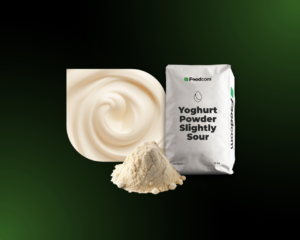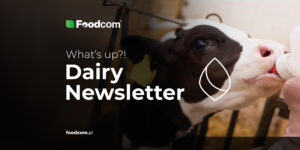- Skimmed milk powder prices remain stable, but forecasts point to a possible increase in Q1 2025.
- Butter and cream increase in price during the festive season, driven by high demand and limited availability.
- In the cheese segment, supply and demand remain in balance, stabilising prices with minimal volatility forecast for 2025.
- Growing demand for sweet whey powder, especially from Asian markets, with production constraints, could put upward pressure on prices.
Welcome Partners!
Welcome back to our Newsletter!
The European dairy market remains generally stable, with certain products facing supply constraints that could drive prices upward. Skimmed milk powder (SMP) is seeing consistent demand from the food sector, keeping prices firm, while butter and cream prices reflect tight supply and high demand, especially approaching the holiday season. Cheese prices are balanced due to steady production, and while sweet whey powder (SWP) remains stable, increased demand from Asia may add pressure. Overall, limited production growth and strong export demand, particularly from Southeast Asia, suggest potential price increases in early 2025.
Let’s see what else has happened recently in the Dairy Market!
Milk Powders
The Skimmed Milk Powder (SMP) market for feed remains stable at 2450 EUR/MT in Q4, with a slight expected increase to 2500 EUR/MT in Q1 2025. Given the ongoing tight supply situation, limited transaction volumes may lead to potential availability issues if demand continues to rise or if supply chains experience disruptions. Such a constrained environment suggests that additional price increases could occur in early 2025 as buyers prepare for the next quarter.
Older product batches are available at 2350-2400 EUR/MT, while fresh SMP is trading between 2400-2450 EUR/MT (FCA). Strong demand from the food sector, particularly in baked goods, desserts, and beverages, continues to drive SMP’s consistent pricing. Despite some supply constraints, pricing remains firm, reflecting the sustained interest and demand in this category. Globally, European SMP is positioned competitively, although it faces some challenges from low domestic demand and tough competition. Furthermore, production in Europe has seen a year-over-year decline, which, combined with export demand from regions like Southeast Asia, could place upward pressure on prices in the medium term.
Cheese
The Cheese market remains stable, with no significant price changes as producers and buyers experience a well-balanced supply and demand. This stability reflects consistent production levels and market absorption, contributing to an equilibrium across major cheese categories in the EU. The outlook for early 2025 suggests a steady market, although the expected increase in milk supply may bring about higher cheese production and thus increased whey availability. This, in turn, could influence prices in the whey market. However, overall, cheese prices are anticipated to remain steady in the near term, supported by strong consumption and limited volatility.
Fats
Butter prices in Europe saw an upward shift in Q4, reaching 7600-7800 EUR/MT, while Q1 2025 currently shows pricing at 7000 EUR/MT with a forecasted rise toward 7200 EUR/MT. This price increase is bolstered by consistent demand, as the lack of import licenses for New Zealand butter or butter oil in the EU could tighten supply dynamics further, supporting potential price firming.
The European butter outlook remains cautious, with high cream prices and limited stocks creating slight upward pressure on prices. However, varying price levels in the US and Oceania may open opportunities for interregional trade if European prices remain less competitive.
AMF prices have remained stable, though high demand and tight EU supply dynamics could lead to slight price increases into early 2025. Limited imports, especially from New Zealand, and slower production growth in the EU have added pressure on AMF availability. In Asia, where demand is strong, European AMF holds valuable trade potential, though high transport costs may cap volumes. Any persistent supply-chain issues could further influence prices.
Liquids
The European market for Cream remains at elevated levels, with prices fluctuating between 9900-10000 EUR/MT (FCA). Strong demand from sectors utilizing high-fat dairy products, along with limited supply availability, continues to support high prices. This trend reflects the consistent preference in the market for using cream as a high-value product rather than diverting it to butter production. The high demand for cream, especially in the run-up to the holiday season, may place further pressure on cream supplies, keeping prices firm through the end of Q4 and potentially into early 2025.
Prices for Skimmed Milk Concentrate have stabilized at 2200-2250 EUR/MT (FCA Germany) and 2250-2300 EUR/MT (DAP NL), attributed to improved product availability, which has eased recent pressures and allowed demand to be met without significant price fluctuations. This balance in the liquid milk concentrate market highlights an increased consistency, supported by stable supplies and managed inventory levels. As the market moves into Q1, this stability is expected to persist, barring any shifts in demand due to changes in the SMP and cheese markets.
Milk prices have been influenced by limited production growth in the EU, as recent factors like higher feed costs and weather-related challenges impacted output. While there is steady demand in domestic markets, export opportunities are also significant, particularly with markets in Asia showing interest. The EU’s milk production is expected to see minor increases, but with input cost pressures still present, a rapid expansion in supply is unlikely. Consequently, fresh milk prices are expected to remain stable to slightly higher in the coming months as supply aligns closely with demand, both locally and in export markets.
Whey Powders
Sweet Whey Powder (SWP) for animal feed has remained stable at 900 EUR/MT in Q4 2024 and is expected to hold steady into Q1 2025, largely due to the sustained demand for dairy protein in animal feed. With global demand strengthening, especially from China and Southeast Asia, which have recorded significant year-over-year increases in imports, the whey market could feel additional upward price pressure in early 2025.
In Europe, SWP production is experiencing constraints, as liquid whey is increasingly diverted to the more profitable Whey Protein Concentrate (WPC) market. This trend has led to a supply squeeze, particularly in Germany, where SWP production has dropped nearly 12% year-over-year. Additionally, with the expected increase in cheese production, which in turn increases whey output, more liquid whey may become available, potentially providing some relief to the SWP market. However, given the strong demand and limited production flexibility, prices are likely to trend upward in the medium term.
What else?
Europe
Belgian authorities have introduced mandatory vaccination against blue tongue and epizootic hemorrhagic disease (EHD) in response to growing epidemiological threats. The decision not only protects the health of cattle, but also ensures the stability of dairy and meat production in the region, protecting against potential losses. In the long term, Belgium’s decision may influence other European Union countries, which may adopt similar precautions to safeguard the livestock sector. Consumers may feel more confident about the safety of animal products, and producers will avoid potential losses from outbreaks.
Asia
As Chinese consumers become more affluent and aware of the health benefits of animal proteins, demand for high-quality products, including dairy, is growing. These changes could open up new export opportunities, especially for producers in Europe and Oceania looking to capture this growing market. Investments in modern production technologies and innovative dairy products are becoming crucial to meet the demands of the Chinese market. This transformation could affect the price of animal proteins around the world, making them more accessible, while strengthening the development of the export sector.
Oceania
Farmers in Australia’s Bundaberg region are raising concerns about water availability in the context of a new national water agreement that could limit their resources. Reduced water availability could disrupt agricultural production, particularly in the dairy and fruit and vegetable sectors, increasing production costs and potentially affecting food prices. These changes could force farmers to rethink their water management strategies and consumers around the world to accept higher costs for products from regions at risk of water scarcity. This situation underscores the urgent need for sustainable solutions in natural resource management.
![Demand for skimmed milk powder and butter is growing and supply chains are feeling the squeeze [242nd Edition of the DAIRY Newsletter] Demand for skimmed milk powder and butter is growing and supply chains are feeling the squeeze [242nd Edition of the DAIRY Newsletter]](https://foodcom.pl/wp-content/uploads/2023/08/Foodcom_SA_Dairy_Newsletter-1520x760.jpg)






